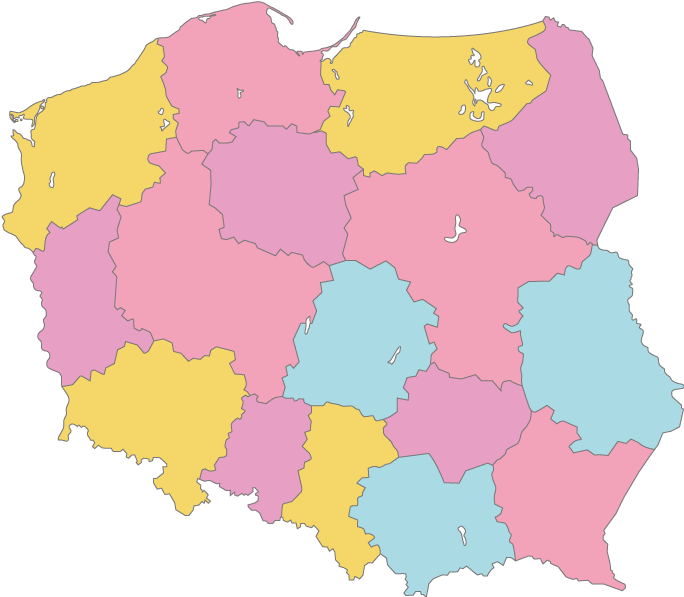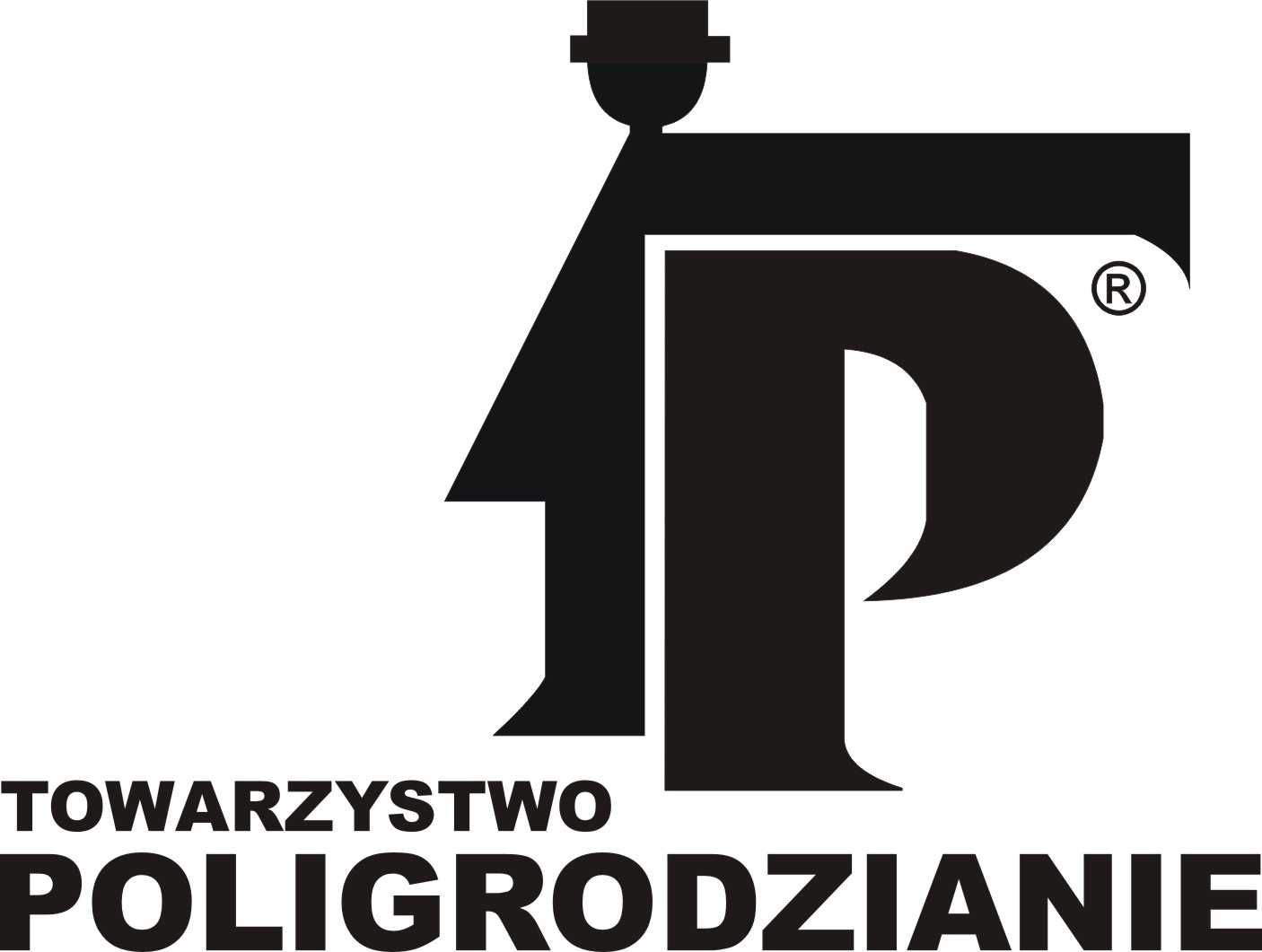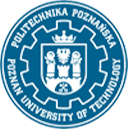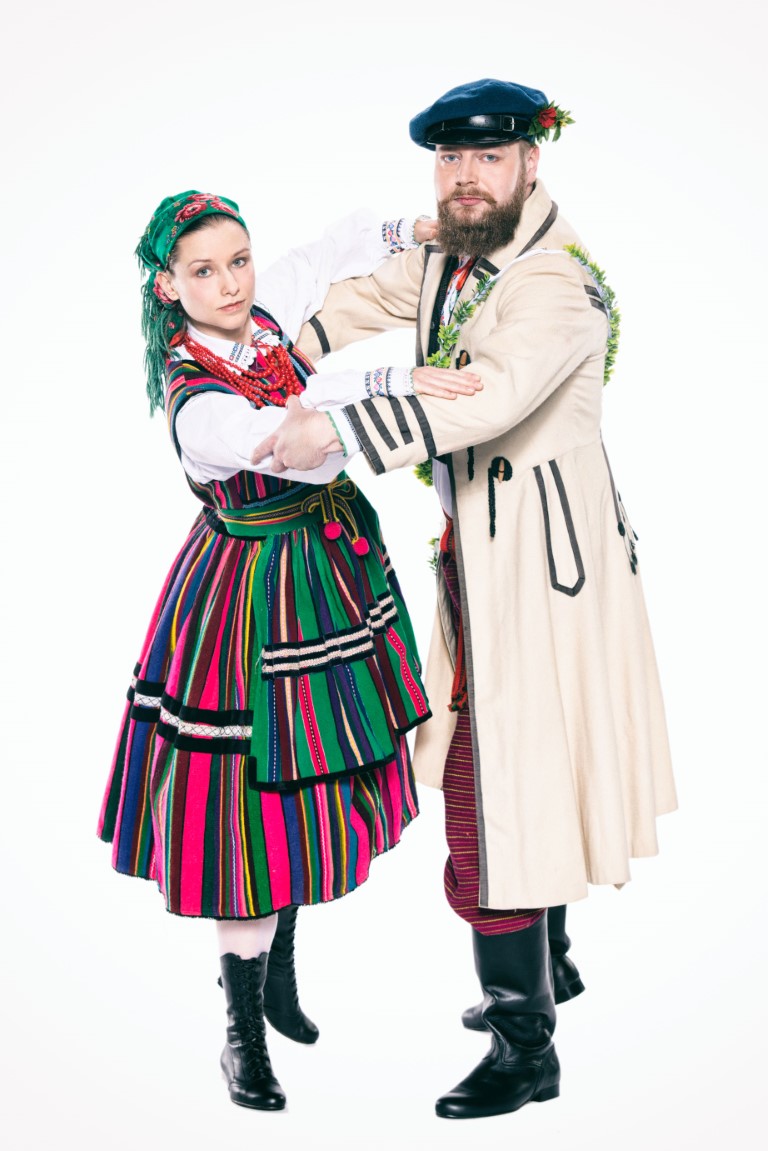

“Bioły Jon” TOP
The Opoczno area is situated in Kielce-Sandomierz Upland, covering the area of Opoczno Hills. It is a region with distinctive features, differing from other ethnic groups in dialect, costumes and many specific elements of folklore. All these characteristics of folk culture contribute to the regional distinctiveness of Opoczno inhabitants. The Opoczno area is a kingdom of lively dances called obereks. They feature a clear dominance of triple metre rhythm, mazurka rhythmics, presence of tempo rubato, wide range of melodies, varied dynamic melodics and fast or very fast tempo. There are also two-measure dances, such as polkas, e.g. the most famous Polka Drygana.
The most primitive musical instruments that could be found in the Opoczno countryside were wind instruments such as pipes, fifes, trumpets and whistles. They were made by their users from twigs, bark, leaves, cereal-crop stems and goose feathers.
The following can be found in the Opoczno area:
- a music band featuring a violin or a squeezebox as the lead instrument,
- a violin, bass, a drum,
- a squeezebox, a violin, baraban (a type of drum), a clarinet in more recent set-ups,
- a violin, a supporting violin, a little drum,
- a violin, a secondary violin, basolia (bowed string instrument).
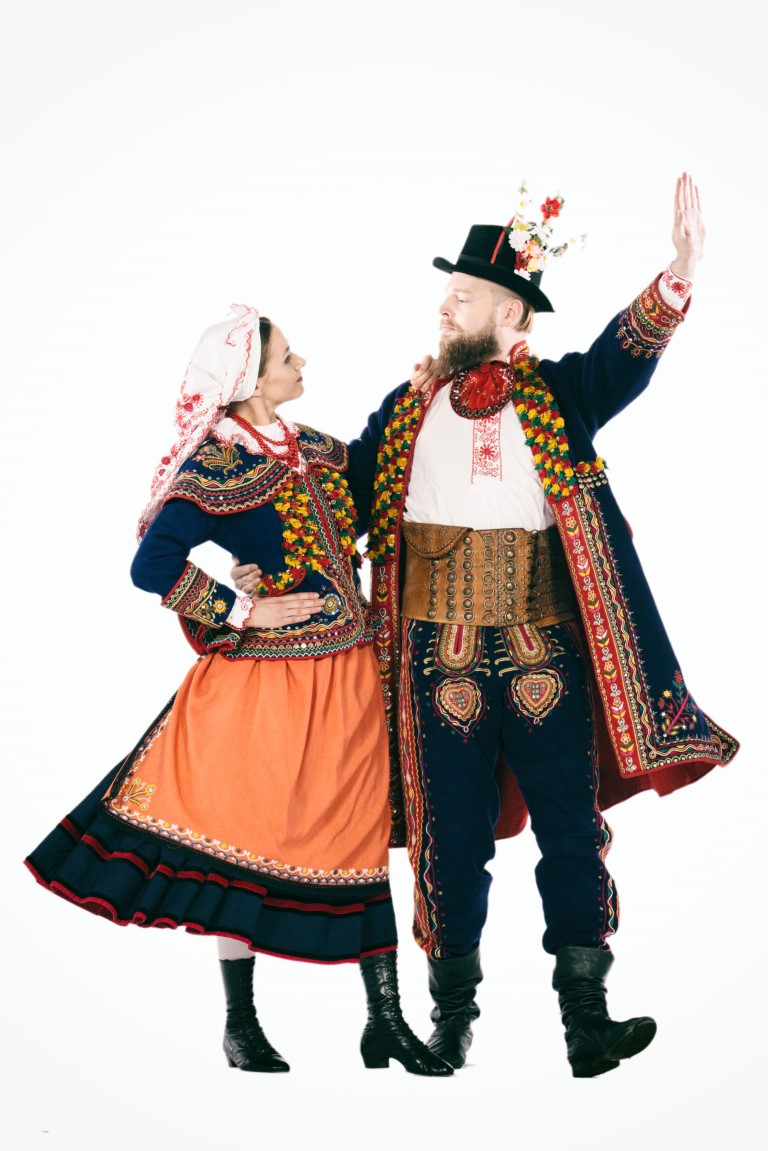

“Turoń” – a carnival from the region of Nowy Sącz, in the south of Poland. Dances and songs from Podegrodzie Region TOP
Sącz Lachs - the name originated by Sącz highlanders - their immediate neighbours in the southern part along the ridge of the Radziejowa range. The culture of Sącz Lachs shows connections with the culture of the inhabitants of Małopolska (Lesser Poland) foothills and the Beskids. Today the most dynamic centre of the culture of Sącz Lachs is the village of Podegrodzie near Stary Sącz.
Clothes worn by Sącz Lachs show influences of clothes worn by highlanders and lowland inhabitants. These inspirations were especially reflected in men's clothing. Sącz Lachs adopted highlanders' wide belts and embroidered pants, and from lowland inhabitants they took the tradition of wearing high boots with pleated uppers instead of traditional kierpce (flat shoes).
Podegrodzie boasts a set of unique customs, rituals, dances, songs, melodies and folk dialect. The most popular are: "Wesele Podegrodzkie" (Podegrodzie Wedding), "Wizowiny", "Zielone Świątki" (Green Week), "Dożynki" (Harvest Festival), sets of melodies, chants and songs, the so-called "Granka Podegrodzka". Typical dances for the region are: krzyżak, sztajer, tramerka, surok, waltzes and polkas.
The authentic Lach culture is characterized by the beauty of costumes, dynamics of dances, melodiousness, harmony and humor of Lach chants.
There is a natural polyphony here, a significant role played by male singers, dominance of double-time, and there are also syncopated rhythms. An interesting instrument used by music bands is Gęśliki Sądeckie. It dates back to 1932–1935. It is a violin-type stringed instrument, made by carving - the bottom plate and the sides are made from one piece of wood. In addition to a violin, the instruments include a second violin, a bass, a clarinet, a squeezebox and, repeatedly, a trumpet.
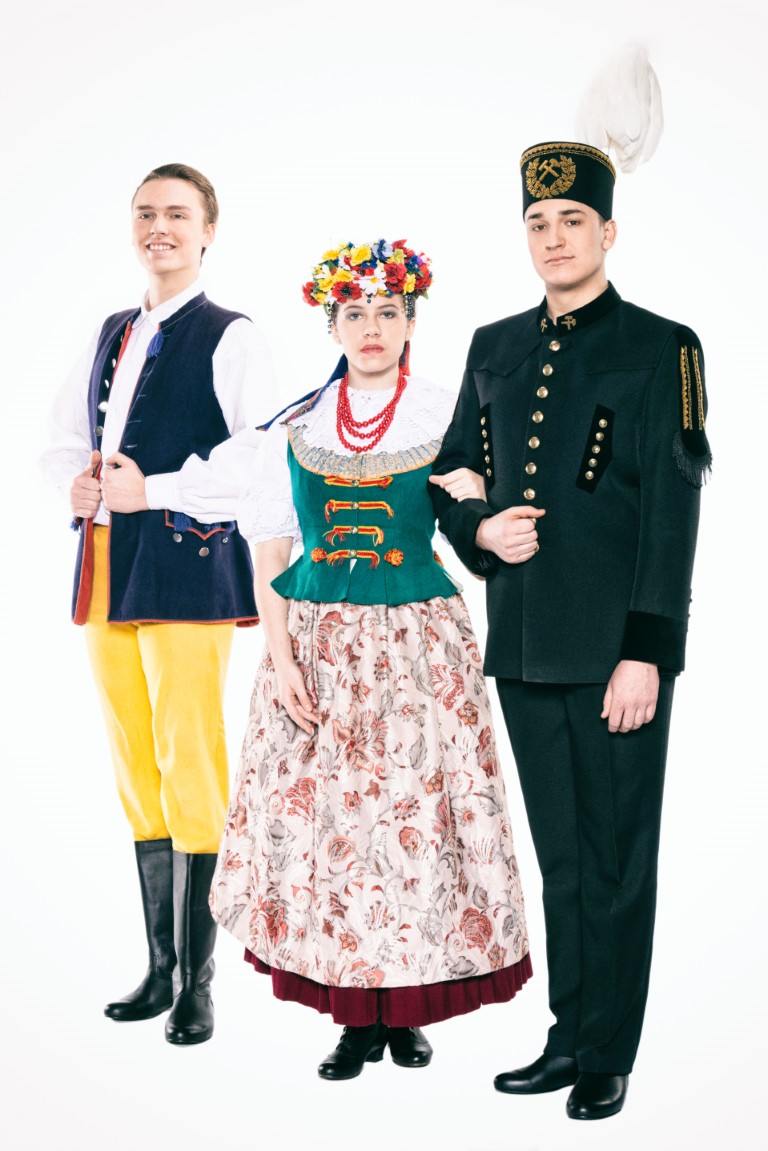

St. Barbara’s Day “Barbórka” in Upper Silesia TOP
Silesia is the ethnographically richest region of Poland. The richness of costumes, interesting rituals, tasty cuisine and different dialect make Silesia a unique region of our country. As the region of Poland, it is usually divided into three subregions - Lower Silesia, Upper Silesia and Opole Silesia. The same can be observed in the ethnographic division.
The most popular holiday in the Silesian tradition is St. Barbara's Day – the patron saint of miners. At that time, the inhabitants of Silesia, wearing festive costumes and accompanied by the sounds of music, went to church services, and after the Holy Mass they took part in the appointment of new hewers and had a lot of fun. Conifers, which often accompanied various rituals, were of great importance in the Silesian tradition. On the first day of spring, after the burning or drowning of Marzanna, a small decorated conifer called gaik - for example spruce, pine or fir - was brought to the village.
Silesian folk bands, old-time string ensembles (violin and bass) have rarely survived to our times. Already in the second half of the 19th century, they were often modified into first and second violins, a clarinet, a cornet or a trumpet, a double bass, sometimes also a flute, a trombone. Wind orchestras consisting of trumpets, cornets, saxhorns, tubas, extended with clarinets and a double-skin drum (even a whole percussion set) also became more widespread. Wind orchestras were especially characteristic of Cieszyn Silesia, Opole Silesia and Upper Silesia, where they operated (partly still operating) at mines.
The most popular dances in the Silesian region are single-pair dances: obracany, polka, waloszki śląskie, grabowy, od buczku do buczku, litery, gołąbek, diabołek, kowol, grozik, jawornicki, holan, zajączek owczarek, kołomajki, etc.
In addition, it should be emphasized that the folk song in Silesia not only expressed the great joy of life, but also treated the world of animals and nature with great respect, appreciated the values of the native land - mother and breadwinner, and the beauty of dear local landscape. It taught how to live in harmony with the whole world and inspired for "solidarity of life in nature".
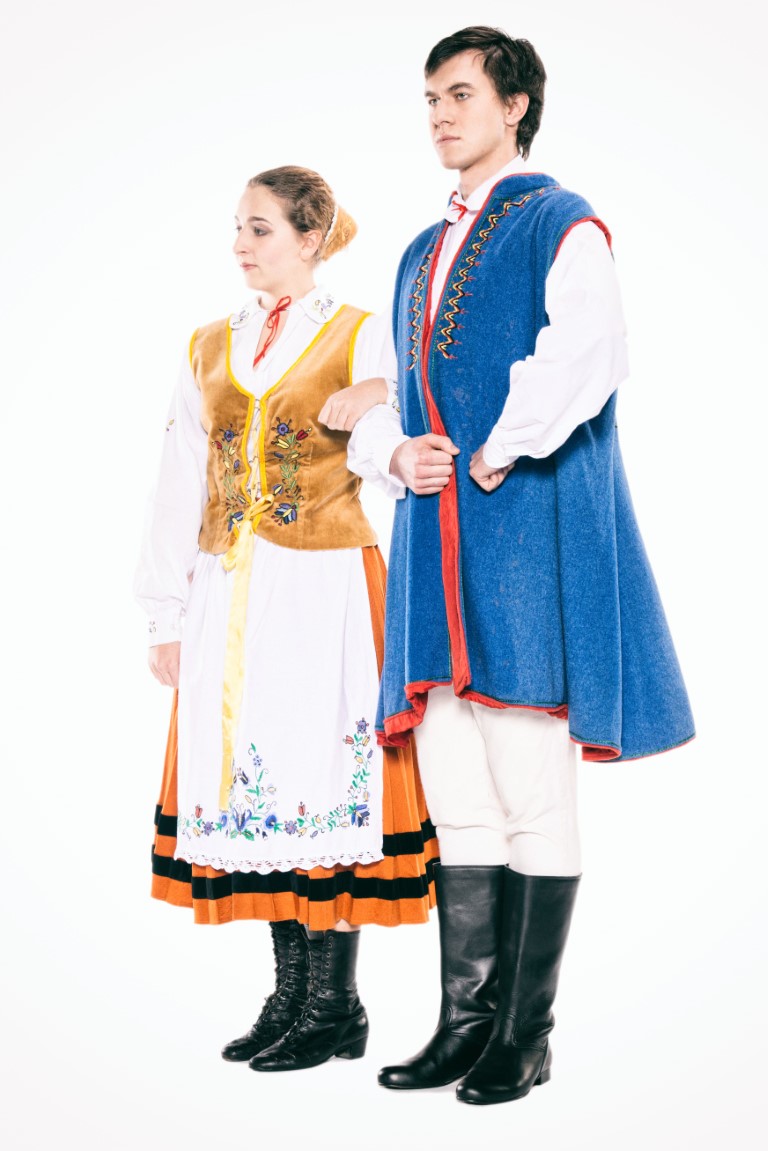

Sheep shearing in the region of Kaszuby TOP
They were performed during various events in the life of Kashubians. They were part of the celebration of various events connected with seasons of the year and family festivities (e.g., harvest or weddings), as well as rituals and ceremonies that often originated in pagan times. Examples of such dances are Rebacki tonc, Koseber or Taniec ognia (Dance of fire). Others were performed for the sheer pleasure of dancing and during courtship. Examples include Maruszka, Okrac se wkol, Nasza koza (Our goat). The remaining ones depicted various jobs, such as Dzek (Sailor), Szewc (Shoemaker), Owczarz (Shepherd) or Klepacz (Craftsman). Some dances were performed to show skills, e.g. Dzek.
Simple melodies that accompany Kashubian dances are written mostly in 2/4 and 5/4 beats, often in main tones. The titles of dialect melodies and song lyrics are in the Kashubian language, which is different from the Polish language. It even has accents such as ã, ë, which are not used in Polish. Kashubians have their own separate language with many features of the old Slavic language. The Kashubian dialect is very different from the rest of Poland. For many people, it is incomprehensible. This is due to the accent and different grammar and spelling.
Music has always accompanied Kashubians not only in important moments in their lives, but also during work or rest. Kashubians like to play, dance and sing. Their dances and songs can be divided into several groups, e.g. ceremonial (connected with birthdays, weddings, baptisms, church holidays, etc.) illustrating everyday work, show-related and entertainment-related.
The instruments used here include: a violin, a double bass, an accordion, burczybas (a drum with an attached strip of horse hair that is pulled to make a sound), a devil's violin, a secondary devil's violin, a secondary accordion and a clarinet. Among the Kashubian instruments one can also find bazuna - a huge wooden trumpet, bandonia - similar to an accordion and many others, including a lot of additional drum-stuff called Przeszkadzajka.
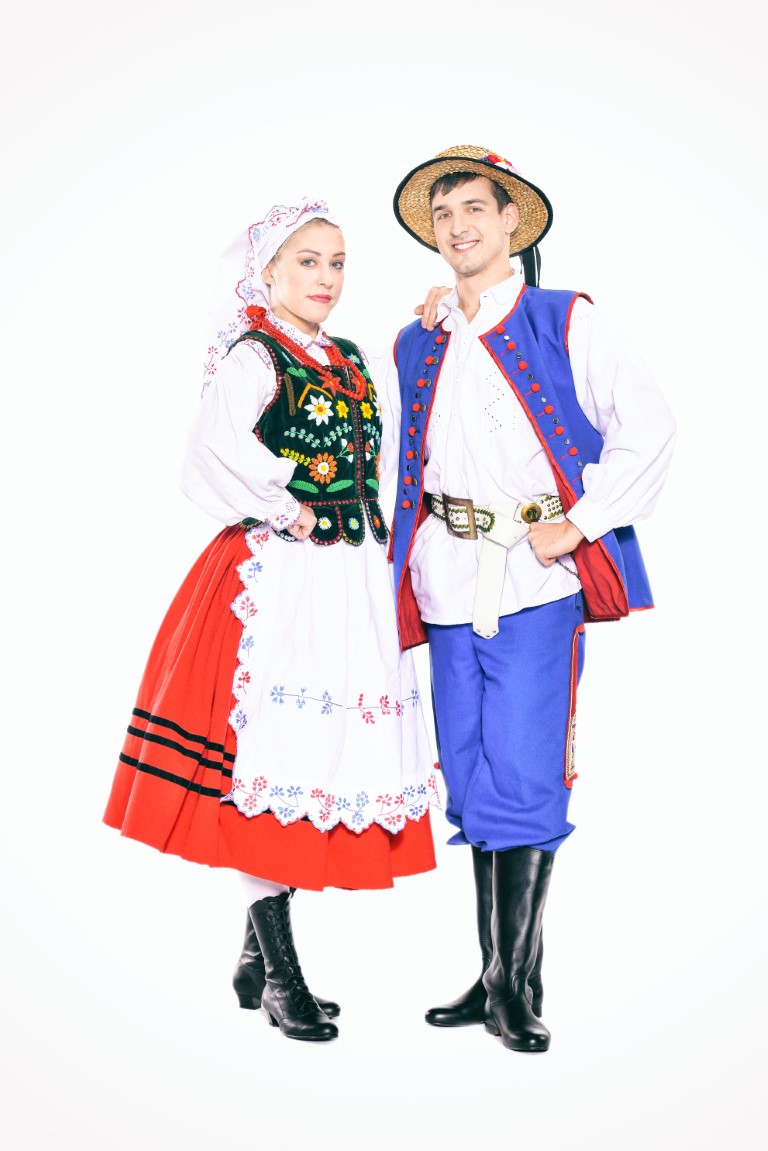

Harvest festival – in the region of Rzeszów TOP
The Rzeszów region, covering the areas of south-eastern Poland, belongs to one of the most culturally diverse areas of our country. The unique role in shaping the folk culture of this region was played by geographical conditions (mountainous and lowland areas directly adjacent to each other) as well as the history of these border lands, being separated from Poland or being returned, depending on the power of the invader or the political situation.
The dance which very well represents the music folklore of Rzeszów is polka, which has many varieties. Rzeszów polkas are distinguished from polkas danced in other regions of the country by a very fast pace and dancing on bent legs - all this while maintaining a very fast pace.
Dances of this region are characterized by liveliness, dynamism, fast pace, and, above all, great freedom, fullness and elegance of moves. A feature that appears much more clearly than in other regions of Poland is autonomy in the selection and sequence of moves, introduced with great fantasy and various additional expressive gestures. A frequent move repeated by dancers is the shaking of the open hand in the air. It is like greeting everybody around, colleagues, girls and expressing a desire to attract attention. The dancer gestures with his raised hand to stop playing music because "he" will now sing and dance. While singing, the dancers spread their arms wide, raise them and take turns to lower them. They often use stressed steps, jumps on the spot, stomps, falling from a jump into a deep squat and hitting the floor with their hands
Names of dances such as "polka dzwon”, "polka trzęsionka”, "polka uginana”, "polka w lewo”, "polka kucana”, etc. come from characteristics of a given dance, an impression they make and the look of dancing pairs. Almost all polkas started with one of the dancers chanting a song, then the band picked up the melody immediately and played it in the key suggested by singing. Among calmer dances, sztajerek and "wolny", also called "chłop", were popular. Rzeszów dances are generally full of movement and at a lively pace, testify to the vivid temperament and cheerful disposition of the inhabitants.
The Rzeszów area features music bands with the following instruments:
- a dulcimer, a violin, bass,
- a dulcimer, a violin, a secondary fiddle, bass,
- a clarinet, a violin, a secondary violin, a double bass.
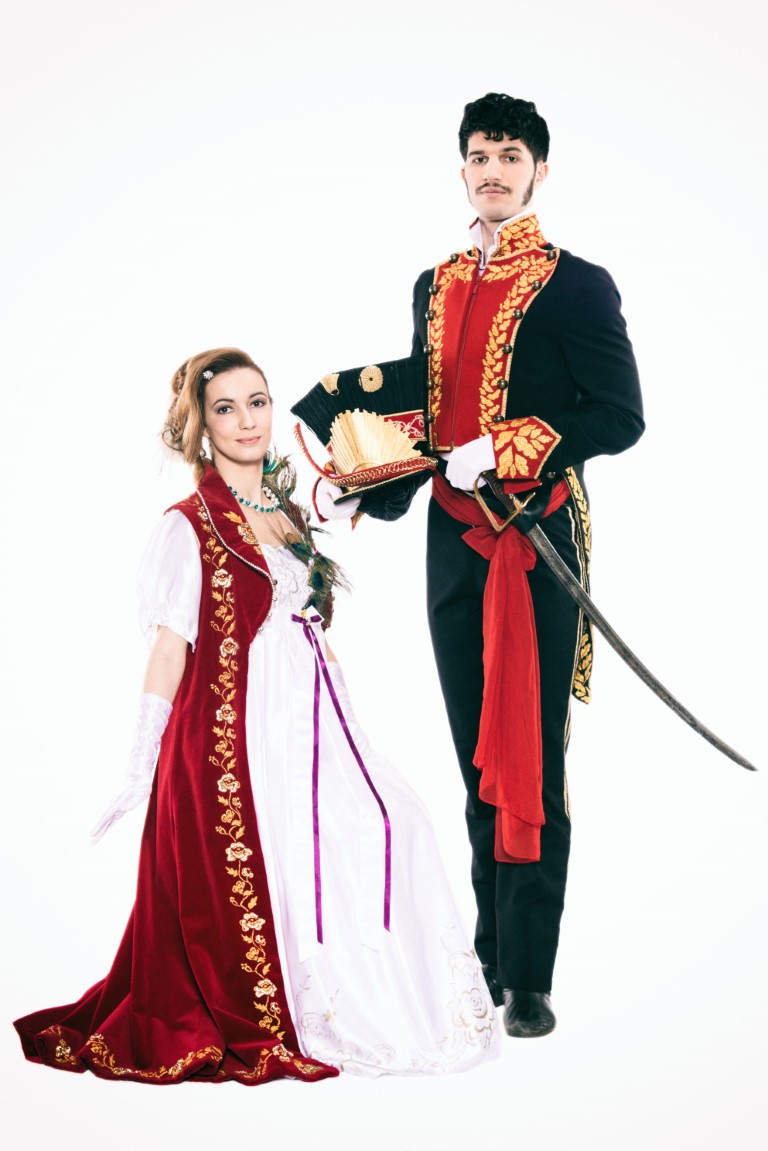

Mazur TOP
Mazur - a Polish national dance, kept in 3/8 metre in mazurka rhythm with accents on the second or third part of the bar and at a lively pace. It is characterized by three steps to the bar of dynamic, fast walking with a flat jump between the third and first part of the bar and swinging steps performed forwards, backwards, sideways or in rotation.
These steps are often supplemented with decorative elements and dynamic accents (heel clicking, heel striking, springing, stamping). The important elements of mazur are free, though conventionalized, hand and head gestures, the improvisational nature of the dance composition in terms of figures arranged by the leader of the dance, and with reference to steps, holds and gestures by individual dancers.
The name comes from an old Polish term for an inhabitant of Mazovia - Mazur - and it appeared at the time when the dance gained popularity among the nobility. Mazur was popular as a salon dance in the 19th century. It was known and danced all over Europe. In France, it was adopted in a changed version under the name of mazurka (female genre). Mazur shows similarities to quadrille, because its figures were arranged by dancers inspired by the figures of quadrille. Depending on the size of a hall, mazur is danced with an appropriate set of figures named okrężna (circular), namiotowa (tented), łańcuchowa (chained), arkadowa (arcaded). Popular in manor houses of the nobility since the 19th century, mazur is danced wearing the Polish national costume called kontusz, sometimes empire dresses and uniforms dating back to the time of the Duchy of Warsaw.
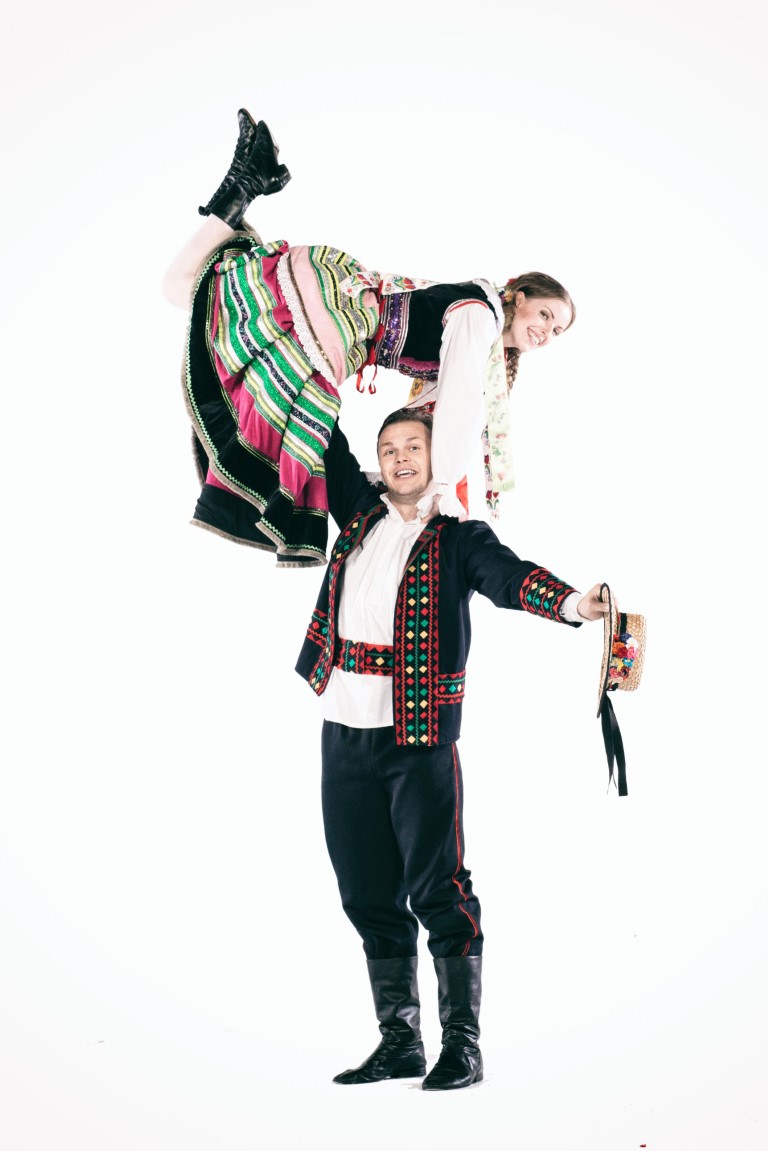

Oberek TOP
Oberek comes from Mazovia. The name of the dance comes from turning. Oberek was popular in villages in many regions of Poland, especially in Mazovia and the Radom area. It was usually danced during weddings and parties, but this custom began to disappear in the second half of the 20th century. In its national form, it is modelled on rural dances from Mazovia.
It is characterized by mazur rhythms with triple metre, 3/8, 3/4 and a lively melody.
Oberek is danced in pairs. The leader is the male dancer, whose task is to perform spectacular figures, such as jumping or kneeling. The female dancer often has to support her partner so that he can make even more sophisticated figures. In oberek, pairs move quickly, often turning on the spot or spinning around the space. Females dance in a fundamental step all the time. The male partner diversifies the dance by incorporating stronger stomps, thumps (the so-called "threes" and "fives"), squats, crouches or heel-clicking. The dance was often accompanied by chants, shouts and stomps.
Other names for this dance are "obertas", "obyrtany", "dłobny", "okrągły", "owijok" (in the Sieradz area), "zawijacz".
In the past, the show in oberek was based especially on persistent spinning in a circle ("on the walls") in two directions ("with the sun" and "against the sun") or four directions (as above, only the partners hold each other in the opposite way). The most persistent dancers wagered musicians who would last longer. They could dance continuously for over half an hour, only changing female partners during this time.
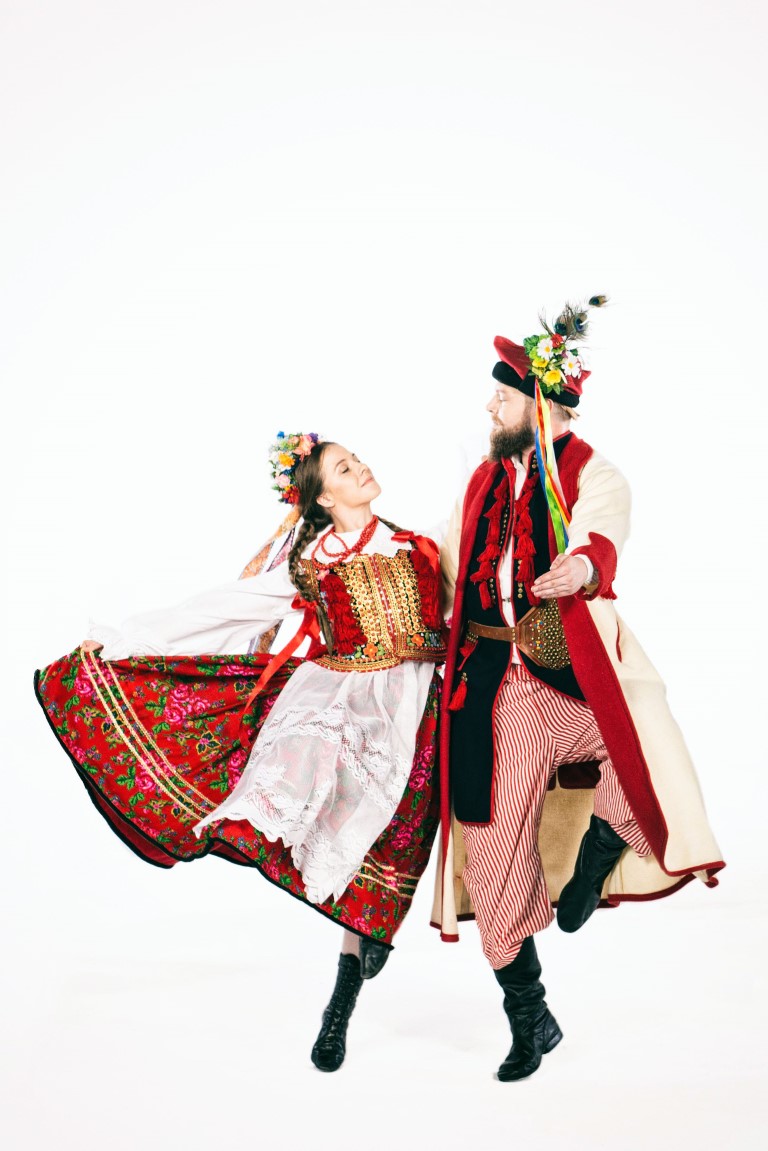

Krakowiak TOP
One could meet people dancing krakowiak in the countryside of the Cracow area as early as in the 15th century, which was mentioned by Mikołaj Rej in his chronicles. Krakowiak is the most popular dance from Cracow, which, along with polonaise, mazur or oberek, has become the icon of the Polish folk dance. This dance gained the greatest popularity at the turn of the 19th and 20th centuries, during the partitions. Currently, it is recognized as an element of the Polish culture, both in Poland and around the world.
The name of the dance comes from the 17th century and referred to a group of dances with their own local names: mijany (passing), dreptany (trotting), ścigany (chasing), skalmierzak, przebiegany (running), etc.
Krakowiak is an improvised group two-measure dance performed in pairs, kept in syncopated and eighth rhythms, at a lively pace. Its characteristic elements are a step forward with a jump, a side step with adduction, numerous heel clicking, striking and accentuated steps, as well as mutual escaping and chasing partners, combined with the passing of dancers.
In the traditional form, dance elements were interspersed with singing by other dancers. In its national form, krakowiak is modelled on the country dances of the Cracow neighbourhood. At the end of the 18th century, the characteristic syncopated rhythms of krakowiak appeared in symphonic music, and at the beginning of the 19th century this dance became popular in stage and instrumental music.
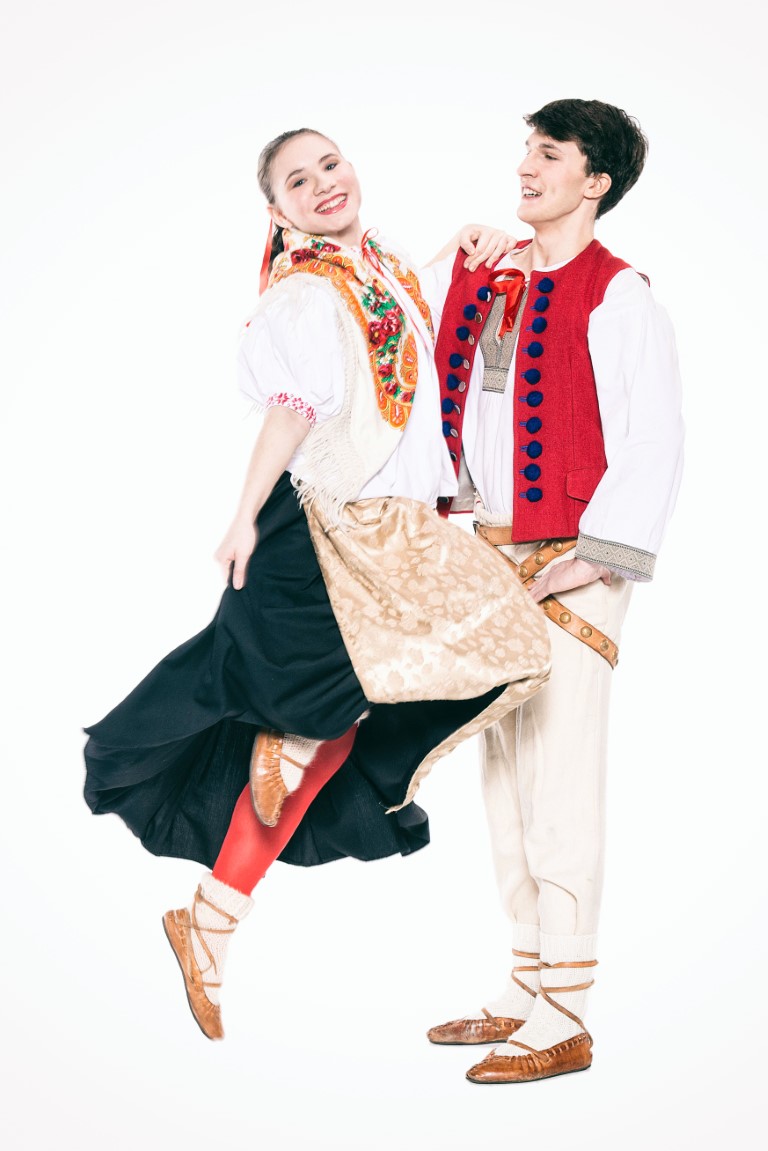

Silesian Beskids TOP
The Silesian Beskids is a region covering the Polish-Czech-Slovak border, which is part of the Western Beskids. Therefore, it borders on the Silesian-Moravia Beskids, the Żywiec Beskids, Żywiec Basin, the Little Beskids and Silesian Foothills.
Silesian highlanders are most likely descendants of Wallachian shepherds who, while wandering, mixed with the Polish, Hungarian and Romanian mountain population. The dances of Silesian Highlanders are characterized by incredible verve and spontaneity. Vigorous dances are interwoven with calmer and melodic chants.
The folklore of the Silesian Beskids consists mainly of party, ceremonial and wedding dances. According to the classification of Janina Marcinkowa, we can list the most popular dances:
- zwyrtany (turning) dances, such as: owięziok, piłka, szewc and masztołka,
- wirowy (swirling) dances, such as: wrona, kowol, łowczorz, klaskany, świniok and zbój,
- single-pair dances: kołomajki, rejna, kucznierz,
- triple and group dances: chustkowy, błogosławiony, czworok,
- show-off dances: żabiok or zajączek.
The basic composition of the Beskids area band, which included a violin and a double bass, also had regional instruments such as gajda (bagpipes), highlander's trumpets, shepherd's fifes and pipes.
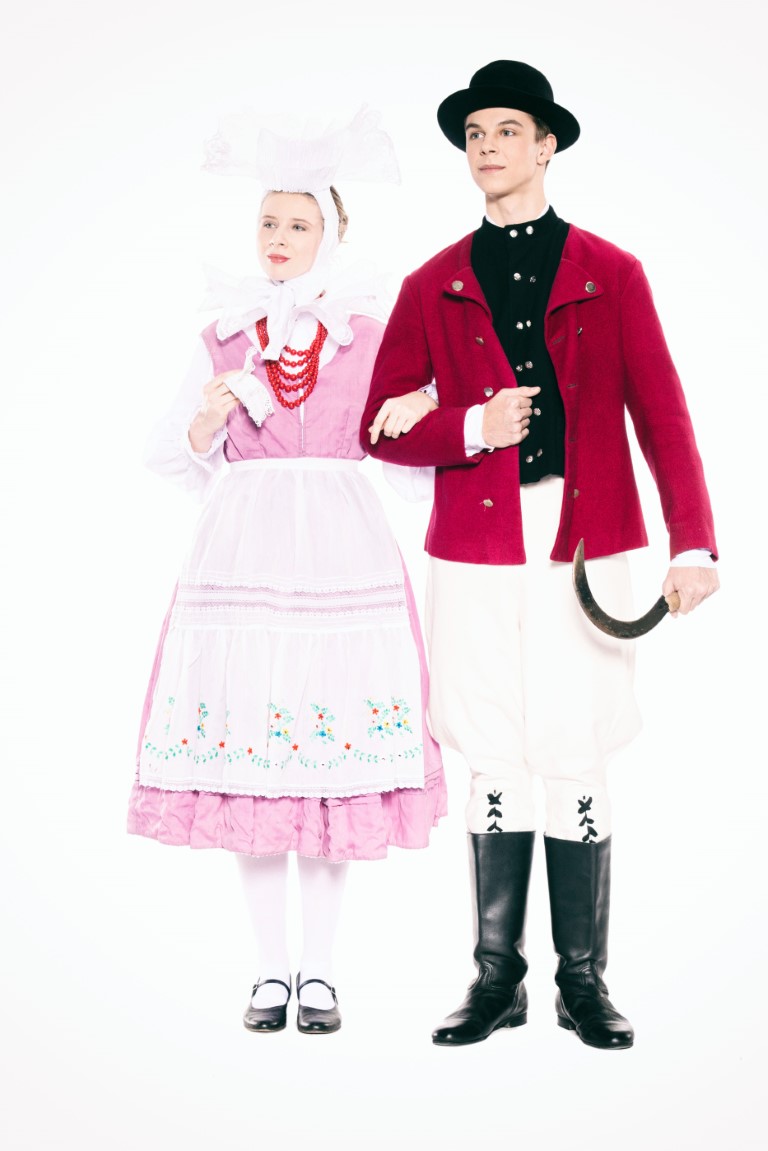

Biskupizna TOP
Biskupizna in Greater Poland consists of only thirteen villages/towns. Together, they create a separate world with their own history, customs, cuisine and costumes. The smallest microregion in Poland has just been added to the UNESCO list of intangible cultural heritage.
Biskupizna formerly belonged to the bishops of Poznań, and each nominal bishop was also the parish pastor of Krobia. Hence the name of the region - Biskupizna (biskup means bishop in English). An extremely important part of the life of the former Biskupizna people was dance, which became one of the most important elements of the local folklore.
Dancing parties in Biskupizna were organized very often, because they gave an opportunity to relax after a hard day's work in the country. Such dancing parties were almost always held in private homes, in cramped rooms, which clearly influenced the form of the folk dances preserved to this day. The dances themselves do not differ significantly in form from dances in other areas of Greater Poland. With some, the only difference is the name. Only some of the ceremonial dances remain characteristic of Biskupizna. The dances characteristic of this microregion are wiwat, równy, przodek, siber, weksel, kłaniany, klepany, szewc, ceglorz.
In the area of Biskupizna, a traditional music band featured bagpipes and a special version of violin set for high-pitch sounds.
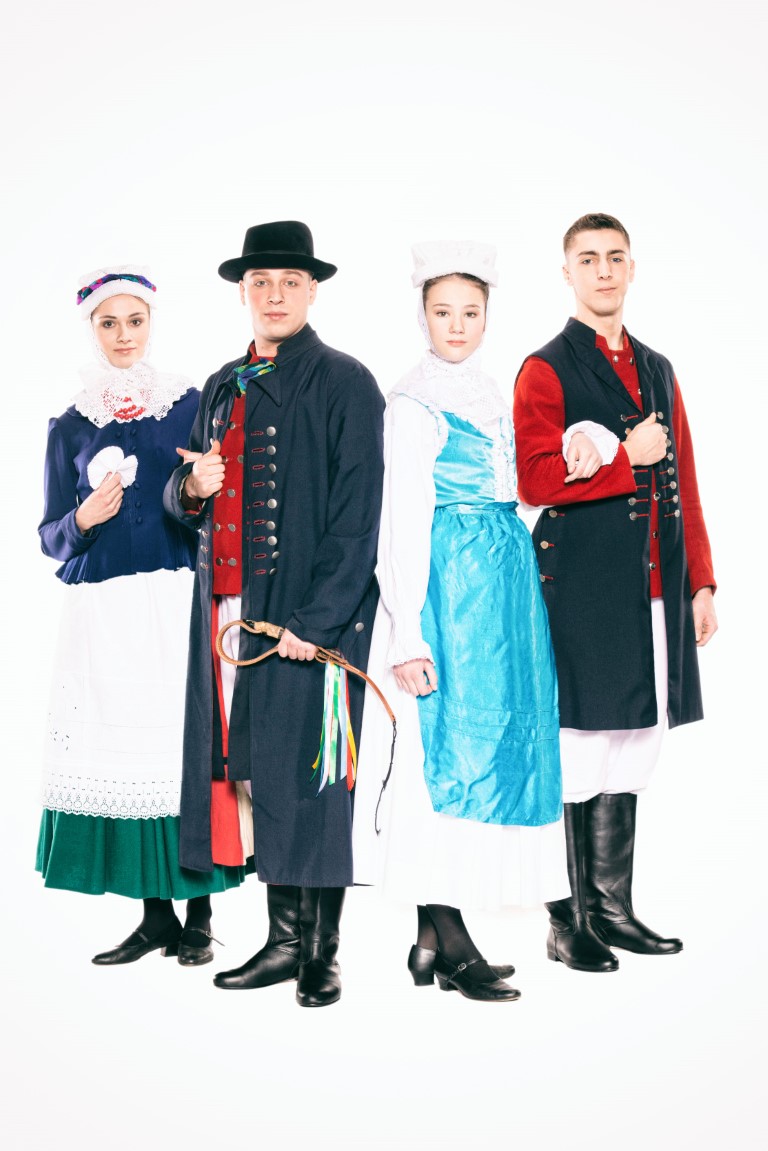

Szamotuły TOP
The dance folklore of Greater Poland, like the musical folklore, was characterized by the richness of forms and regional diversity. It is dominated by wiwaty, chodzone, marches, and oberek forms (called "behind the circle"). The oldest and most numerous dances are wiwaty- dances associated with songs characterized by varied pace, musical metre and mood. Also noteworthy are przodki performed to the melody of wiwat or chodzony. Przodki are dances with figures ordered for one couple who danced in the centre while the other dancers walked or ran around the circumference of the circle. The best-known przodek is "Rada nie rada". "Newcomers" from other countries were also popular: walcerek, tyrolinka, polka, and lender. The most famous dances in the Szamotuły region include: Wielki ojciec (Big father), Poniewierany, Polka from Szczuczyn, Marynia, Gołąbek (Dove), Lusterkowy, Chusteczkowy. The dances and songs of the Szamotuły region are presented to the accompaniment of a violin, a clarinet and maryna - an extremely rare instrument (known only in the Szamotuły and Pałuki regions).
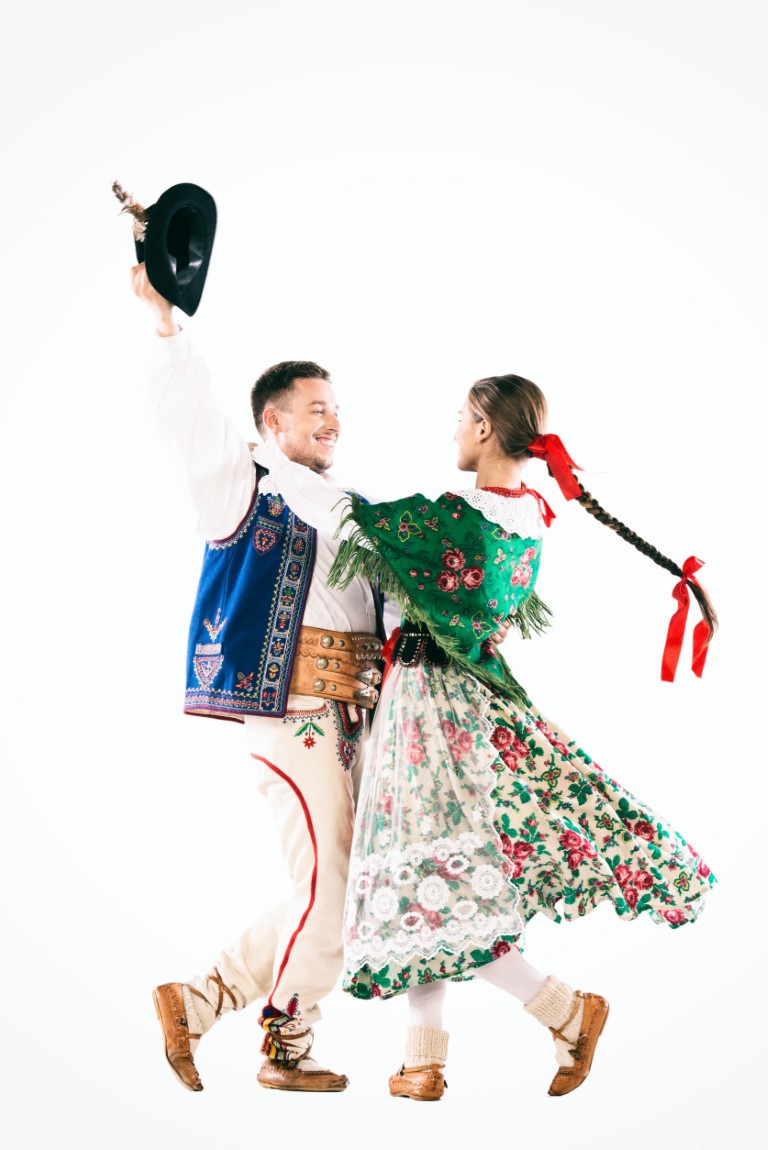

Pieniny Mountains TOP
The region of the Pieniny Mountains - a small area surrounded by Podhale, Spisz, the Sącz Beskids and formerly Ruś Szlachtowska (Shlakhtov Ruthenia), and its inhabitants are characterized by a specific culture. The adjacent villages and hamlets around Szczawnica and Krościenko, although constituting the principal part of the region, differ in small elements in their costumes, music, singing, speech and dances - especially in their performance.
The most popular dances include obyrtans, polka, sztajerek, Żyd (Jew), ogrodnik (gardener), zbójnicki (robber dance).
In addition, there are ceremonial and wedding dances, such as “Women's dance before the unveiling ceremony”, “Guiding the bride by the matron of honour”, “Dance of the matron of honour and bridesmaids around the veiled bride” or “Groom's dance with the veiled bride”.
The Pieniny region is also characterized by a specific way of making music characterized by natural polyphony, a significant role of male singing, domination of double-measure, syncopated rhythms and often a five-bar form.
The band consists of musicians with the following double instruments: a violin, a secondary violin, a 3-string bass.
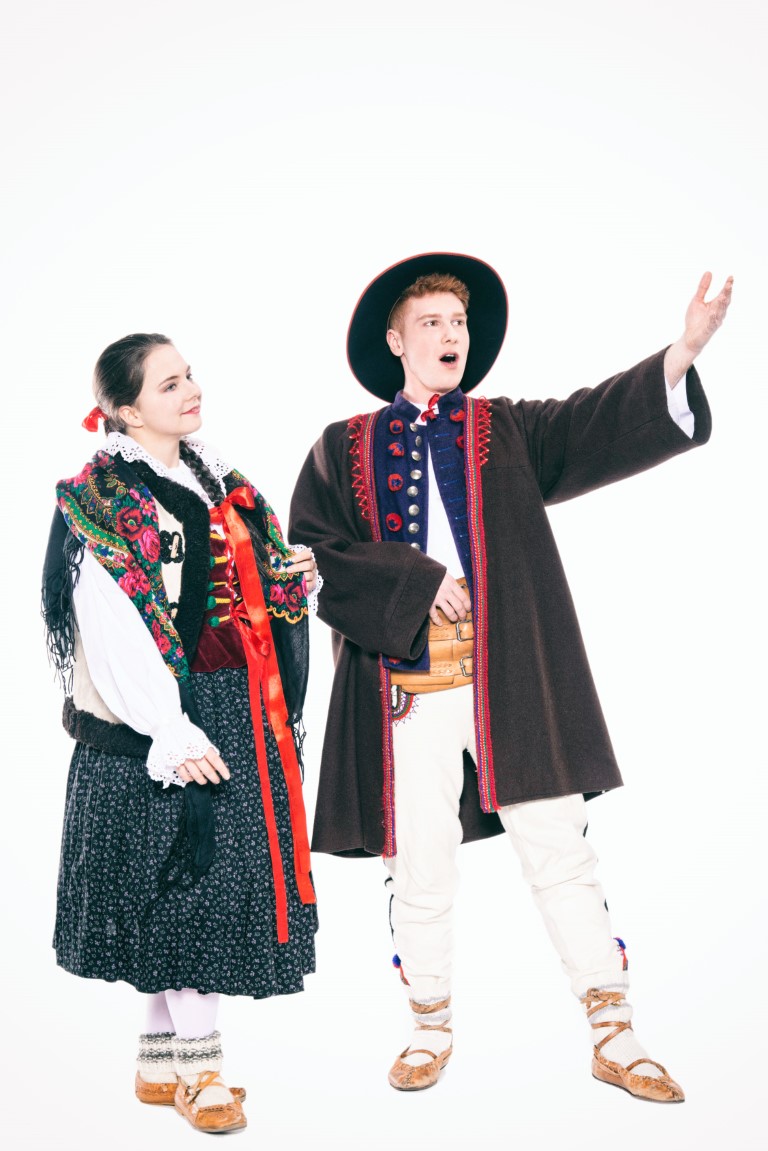

Żywiec Beskids TOP
The characteristic and still performed dances in Żywiec are obyrtka, hajduk, siustany, koło (circle), krzyżok (cross), na bon and koń (horse). Other well-known dances included krakowiaks, polkas, waltzes, Silesian dances and polonaise danced mainly by the middle class of Żywiec. The so-called "dziad" has survived from the parody-party dances.
Three dances are particularly characteristic: koło (circle), koń (horse) and bon. When danced, they show traces of "koło" and "obyrtek" and features of rituals. They are also danced around the circumference of the circle with singing, and the dancers fall into trance, often surrendering to the music. They are lively and danced at a faster pace than "koło" but dignified. All three of the above are run by a "leader" - it must be someone who suggests changes in figures, dance directions, changes in melodies, while making sure that the dancers follow the direction of the dance and do not succumb to excessive dance "fantasy". During all the dances, the dancers shout and whistle, and the female dancers exclaim "juhuhu".
The characteristic features of the music of Żywiec are the manifestations of free rhythmics, frequently changing musical metre and traces of five and seven-measures. There are very few longer melismas in the Żywiec region and very frequent exclamations appearing in folk songs, "squeaking" and "hooting" with a falling melody line.
In the Żywiec Beskids we meet two bands:
- gajdy (bagpipes), a violin,
- a violin, a second violin, heligonka (accordion), bass (double bass).
There are also thrombines and fasting pipes.
Many ancient musical instruments have survived to the present day in the Żywiec region. Mostly wind instruments related to shepherding are dominant here. The oldest musical instruments include leaves, children's whistles called squeals and lures called "kusocami" or "sowy" (owls) in the Żywiec Beskids. The simplest forms of reed-wind instruments, found in the Żywiec Beskids are simple children's "squeaks", which are primitive clarinets made of rye stalks. In the Żywiec region, there was also a 250 mm long clarinet trumpet made of spirally-wound bark and a reed made of the shaft of a bird feather.
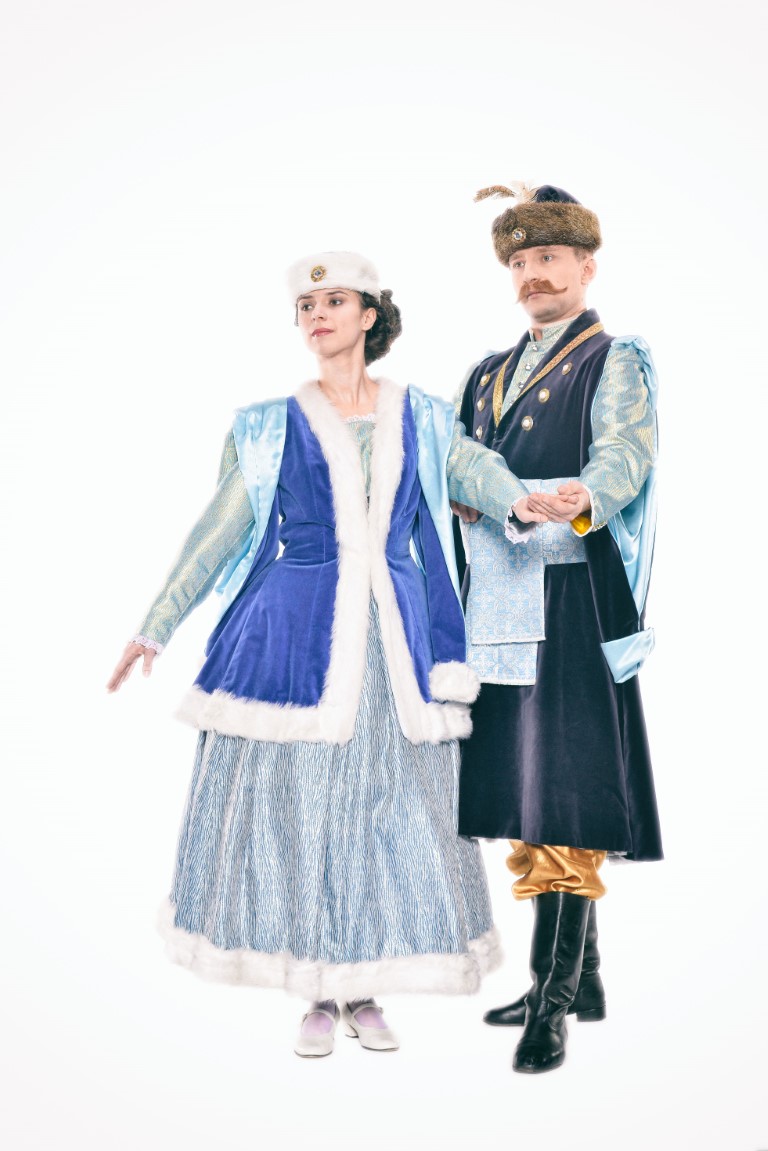

Polonaise TOP
Polonaise – a Polish national dance, formerly known as the court dance, is an ennobled version of the folk dance known as "chodzony" (walking).
Polonaise is a triple metre dance, at a moderate pace and the eighth rhythmics with two sixteenth notes on the 'i' of the first measure. It is a processional dance. The old Polish name of polonaise is "chodzony" (walking) and it accurately reflects its character - it consists in dignified walking in pairs along winding and straight lines marked by the leader. The steps of polonaise are sliding and flowing in nature, in a moderate or slow tempo. The silhouettes of dancers should be upright and their heads proudly raised to emphasize the solemn, ceremonial style of the dance.
The first accounts of the existence of "chodzony" (walking) come from the second half of the 16th century. Since the beginning of the 19th century, it has been widely recognized as the oldest national dance, the form of which, cultivated among the upper classes, was a refined version of dances that had been present in Polish society for centuries. In the national ideology, polonaise is a dance emblem of Polish culture, expressing the Sarmatian chivalrous ethos and moral norms in social relationships (especially intergenerational and male-female relationships).
Polonaise is danced in the Polish national costume (kontusz). Empire dresses and uniforms from the time of the Duchy of Warsaw are also possible.
In the stylized form, polonaise appeared as a musical style in the baroque suite, and many later composers picked this style. The most famous polonaises in the world were composed by Fryderyk Chopin, who turned them into masterpieces of classical music, an example of which is the Polonaise in A flat major (opus 53), often associated with Poland.
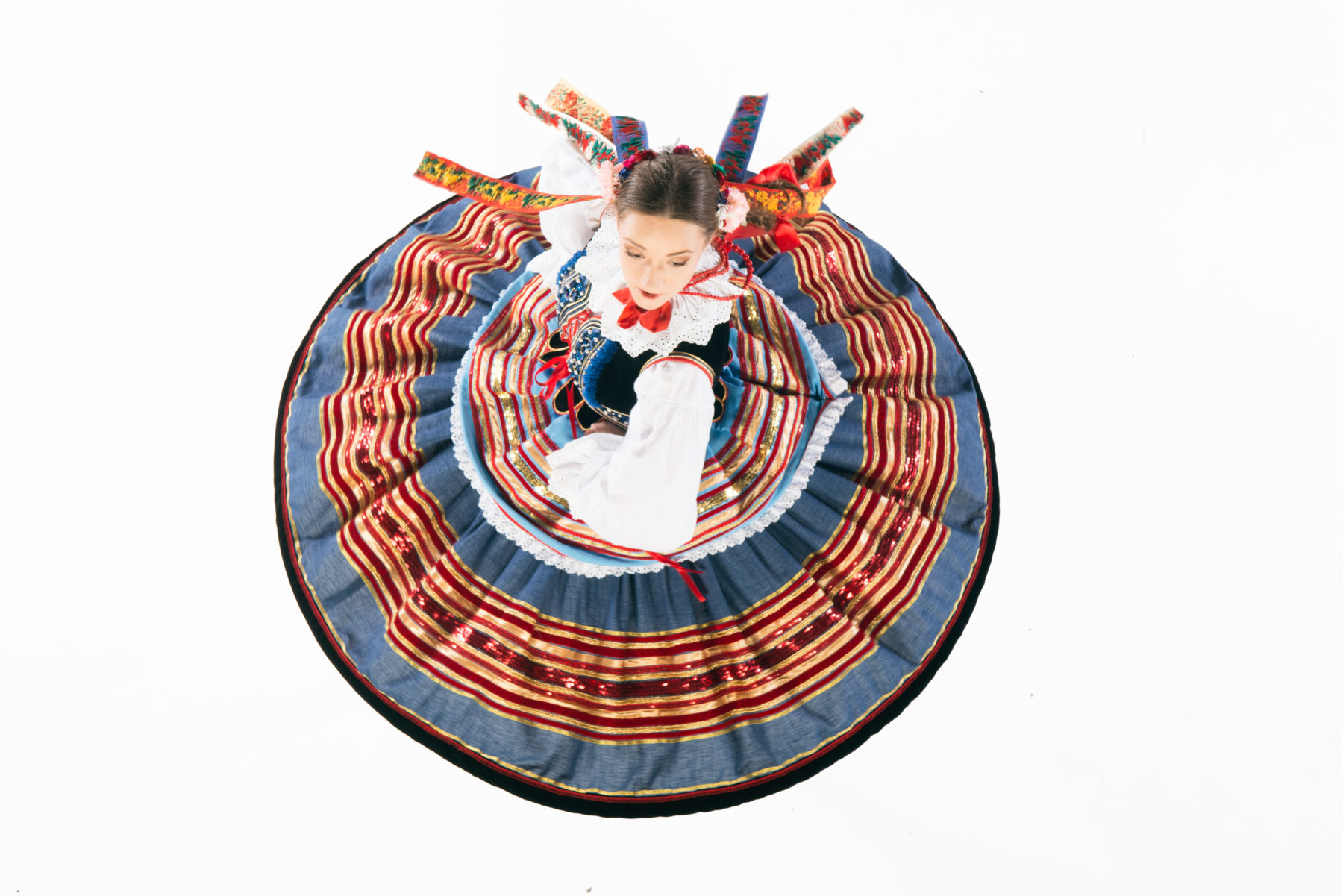

Kujawiak TOP
Kujawiak is a leisurely dance in 3/4 metre, performed in tempo rubato. According to the musicological classification, kujawiak belongs to mazurka rhythms. Apart from it, this category also includes mazurka proper and oberek. Kujawiak is the slowest of them. It was usually performed with chants. A romantic, lyrical melody gives it a flirtatious character.
It consists in walking in the rhythm of quarter notes on slightly bent legs. The dance steps are mainly based on gentle gait and turns, only the musical accents at the end of the phrase are emphasized by stronger tapping. Couples after couples dance together around the circumference of the circle. The male dancer is on the left, one step ahead of his partner. The dancers face each other. The male dancer grasps his female partner with both hands above the waist. The female dancer at the same time grasps her partner from the sides. The dancers occasionally raise their right arm and shake it high. From time to time, they open their arms and dance embracing each other behind their backs (the male dancer with the left hand, the female dancer with the right hand, when the female dancer is on the left, or vice versa).
The dance leaves a lot of room for improvisation and the inventiveness of the dancers, whose willingness and temperament will affect the embellishment of the dance with gestures or stomps. The Kuyavian dance actually consists of three dances, with ever faster and faster rotation:
1. chodzony (walking), i.e. Polish;
2. odsibka, ocibka, i.e. kujawiak proper;
3. ksebka, i.e. mazur.
If these three dances are performed one after another, they can be collectively called a round dance.
Organizer
Project co-financed by


